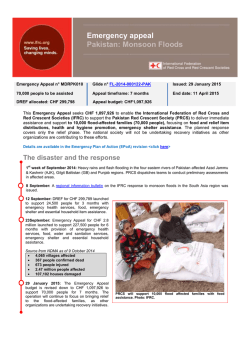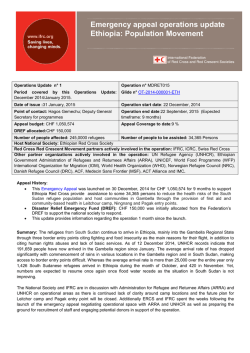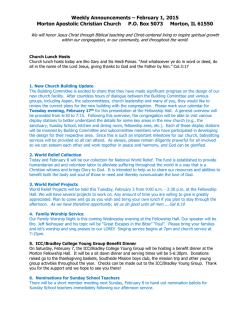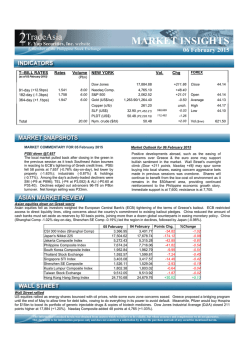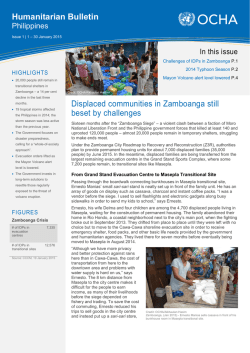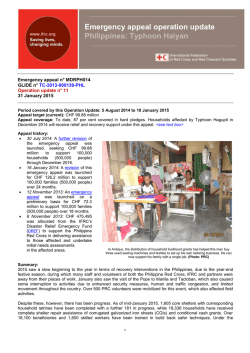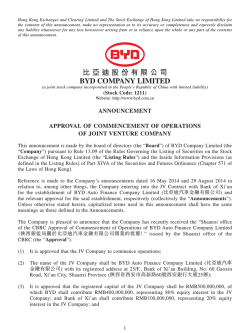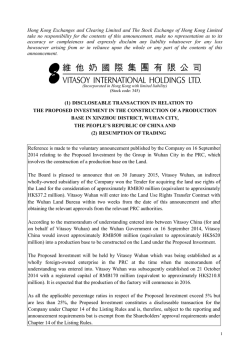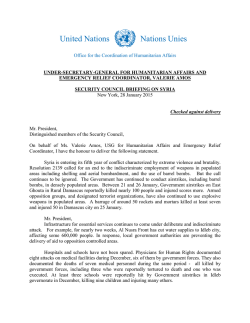
DREF final report Philippines: Typhoon Rammasun
DREF final report Philippines: Typhoon Rammasun DREF operation: MDRPH015 GLIDE n° TC-2014-000092-PHL Date of issue: 30 January 2015 Date of disaster: 15 July 2014 Manager responsible for this DREF: Point of contact: Kari Isomaa , Head of Delegation, IFRC country Gwendolyn Pang, Secretary-General, Philippine delegation Red Cross Operation start date: 15 July 2014 Operation end date: 31 October 2014 Operation budget: CHF 260,000 DREF allocated: 1 August 2014 Number of people assisted: 55,000 people Host National Society: Philippine Red Cross is the nation’s largest humanitarian organization and works through 100 chapters covering all administrative districts in major cities in the country. It has at least 1,000 staff at national headquarters and chapter levels, and approximately one million volunteers and supporters, of whom some 500,000 are active volunteers. At chapter level also, a programme called 143 volunteers is in place to enhance the overall capacity of the National Society to prepare for and respond in disaster situations. Red Cross Red Crescent Movement partners actively involved in the operation: IFRC, Australian Red Cross, Canadian Red Cross Society and Spanish Red Cross Other partner organizations actively involved in the operation: Governments of Australia and New Zealand also provided relief supplies. Summary: Typhoon Rammasun (locally known as Glenda) made landfall over the town of Rapu-Rapu, Albay province, east of the Philippines, in the afternoon of 15 July. It crossed the National Capital Region (NCR) the next morning, 16 July, pounding Metro Manila with strong winds and heavy rain, causing power outages and interrupting communication lines in its path. Rammasun exited the Philippine Area of Responsibility on 17 July. A state of calamity was declared in 12 provinces, seven cities and 48 municipalities across six regions. According to the National Disaster Risk Reduction and Management Council (NDRRMC), the typhoon affected more than a million families, displacing more than 600,000 (three million people) of them. In the aftermath of the typhoon, more than 100 people were reported dead, 1,250 people injured and five are still missing from eight regions across Luzon and Visayas. More than 600,000 houses were also damaged, totally damaging more than 110,000 of them. Rammasun also left extensive damages in infrastructure, school facilities, agriculture, private properties and lifelines amounting to more than PHP 38 billion (CHF 747 million). A DREF allocation of CHF 260,000 was issued by IFRC to support the Philippine Red Cross (PRC) in responding to the aftermath of Rammasun. Of which, only CHF 173,921 (67 per cent) was spent. The unspent balance of CHF 86,079 is to be returned to the DREF pot. The main reason for under-utilization is due to significant PRC provided food and non-food items to provide immediate relief to bilateral donations from other partners (Canadian Red the affected population. Photo: PRC Cross Society and Spanish Red Cross), which went to covering for part of the food distribution targets and operational costs that was initially budgeted under this DREF. This enabled PRC to scale up the provision of food packages from 2,000 families (DREF) to 11,000 families. 2 Furthermore PRC, through the DREF, managed to replenish the tarpaulins that were dispatched to its chapters in affected areas to meet immediate shelter needs of some 5,000 families. Coordination and partnerships Overview of Red Cross Red Crescent Movement in country The IFRC liaises frequently and supports any coordination with its Movement partners (PRC, PNS, and ICRC) as well as with its external organizations as needed.. Overview of non-Red Cross Red Crescent actors in country Coordinating with authorities As auxiliary to public authorities, PRC maintains a strong relationship with government bodies through participation or collaboration with (i) NDRRMC; (ii) provincial, municipal and barangay (village) disaster risk reduction and management councils; (iii) provincial, municipal/city social welfare and development agencies; (iv) the local government units as defined in the Disaster Risk Reduction and Management Act of 2010. Assessment and monitoring of areas affected were also undertaken by PRC chapters in coordination with local governments and local disaster risk reduction and management councils. Inter-agency coordination At country level, PRC and IFRC participate in Humanitarian Country Team (HCT) meetings held both during disasters and non-emergency times. PRC and IFRC are involved in relevant cluster information sharing, planning and analysis at all levels while IFRC supports PRC coordination efforts through representation in other relevant clusters as required. Regionally, the IFRC Asia Pacific zone office participates in regional Inter-Agency Standing Committee (IASC) meetings; while globally, the IFRC has taken part in the IASC Principles and Emergency Director meetings. Operational implementation Overview The PRC responded swiftly to meet the immediate needs of families affected by Rammasun by mobilizing more than 1,200 volunteers and some 150 staff members as well as relief items from its preparedness stocks. Assessment teams from the National Headquarters and chapters were deployed to areas affected by Rammasun to help determine the nature and extent of needs. The allocation from DREF was made to enable the National Society to cover the costs of deploying the assessment teams, replenishing tarpaulins that it had released from its preparedness stocks, provide food to affected families and to support expenses relating to distribution and monitoring. To address immediate needs of people who sought refuge in evacuation centres, PRC served hot meals to 24,188 people, provided psychosocial support to 8,236 individuals, The Philippine Red Cross provided more than 270,000 litres of clean water to almost 60,000 people affected by Typhoon Rammasun. distributed bottled water to 12,860 people and Photo: PRC 271,263 litres of safe water to 59,730 people. Relief interventions targeted families in evacuation centres and communities. At the conclusion of the relief intervention, PRC had provided 11,000 families with food packages and up to 5,900 families with non-food relief items including hygiene kits (2,800 families), mosquito nets (5,500 families), jerry cans (2,500 families), sleeping mats (5,900 families) and blankets (5,570 families). Specifically, the DREF allocation enabled PRC to provide food packages to some 2,000 families and replenish the tarpaulins that were dispatched to meet immediate shelter needs of some 5,000 families. It also covered the costs of deploying assessment teams as well as expenses relating to distribution and monitoring. 3 Quality programming Outcome: Continuous and detailed assessment and analysis is used to inform the design and implementation of the operation Outputs (expected results) Activities planned Initial needs assessments are Assessment report findings updated according to findings Sectorial plans with activities meeting specific beneficiary needs Impact: PRC completed the assessments of areas hit by Rammasun in late July. Response plans were implemented for the chapters and the National Headquarters (NHQ). The chapters were tasked with rescue operations and setting up of 95 welfare desks, as well as distribution of relief supplies to the affected population. Assessment and monitoring of areas affected were also undertaken by the chapters, coordinating with local governments and local disaster risk reduction and management councils. Emergency relief items were distributed according to the results of the assessments which showed that families needed hot meals, food rations, essential nonfood household items and emergency shelter items. Results of the assessments also showed that pre-emptive evacuations in some areas prevented casualties. Before, during and after the typhoon, the PRC NHQ was on alert and in close coordination with the Philippine Atmospheric, Geophysical and Astronomical Services Administration and the NDRRMC, and continuously provided chapters with updated information and consolidated data as Rammasun battered Luzon. Assessments were also supported by in-country PNS who have ongoing programmes in the affected areas. For instance, the IFRC briefly reassigned its field delegate working for Haiyan operations to the Rammasun operations. The Spanish Red Cross also funded assessments conducted in the provinces of Camarines Norte and Camarines Sur. Information was shared by partners which helped to further inform the overall planning for response by PRC, IFRC and all partners to the affected communities. Shelter and settlements (and household items) Outcome: Essential household non-food items to meet the needs of 10,000 families over three months Outputs (expected results) Activities planned Mobilize volunteers and provide them with orientation on beneficiary revalidation process and distribution protocols Identify, register, verify and mobilize beneficiaries for distribution Affected families have access to essential household non-food Distribute non-food items to 10,000 families (including items emergency shelter and relief items) Conduct a post-distribution survey Monitor and report on distributions Impact: Damages to more than 600,000 houses prompted PRC to distribute tarpaulins and non-food household items to families to provide them with protection from the elements as well as items to be used for their daily activities. Through volunteers and staff, PRC provided 5,900 families with non-food relief items including blankets (5,570 families), hygiene kits (2,800 families), jerry cans (2,500 families), mosquito nets (5,500 families) and sleeping mats (5,900 families). Furthermore, PRC replenished the tarpaulins that were dispatched to its chapters in affected areas to meet immediate shelter needs of some 5,000 families (1,500 in Batangas, 2,000 in Quezon-Lucena and 1,500 in Sorsogon). Food security, nutrition and livelihoods Outcome: Basic food assistance to meet the needs of 5,000 families over three months Outputs (expected results) Activities planned Mobilize volunteers and provide them with orientation on beneficiary revalidation process and distribution protocols Identify, register, verify and mobilize beneficiaries for Affected families have access to distributions basic food assistance Distribute basic food items to 5,000 families Conduct a post-distribution survey Monitor and report on distributions Impact: During the emergency phase, PRC served hot meals to 24,188 people inside evacuation centres. In addition, 1 PRC provided food packages to 11,052 families (55,260 people) to address food needs of affected families during the relief operations. Of these, 2,000 food packages were supported by this DREF, with the remaining supported by other partners. Table 1. Summary of food packages supported through the DREF Province Number of families Albay 400 Cavite 300 Laguna 150 Northern Samar 150 Quezon 1,000 Total 2,000 Challenges Typhoon Rammasun struck at a time when the Red Cross and other humanitarian actors were also responding to the needs wrought by Typhoon Haiyan. Significant resources of the Philippine Red Cross, including volunteers and staff, were therefore handling multiple responses. Furthermore, Philippines continued to contend with other hydro-meteorological and geological events such as minor earthquakes, floods, tropical storms and the threat of volcanic eruption. Some of these occurred in areas where communities are still recovering from previous disasters including Typhoon Rammasun. Owing to this situation, no post-distribution survey was undertaken. Nevertheless, based on beneficiary feedback obtained in similar surveys undertaken during previous operations covering the same geographical areas of this DREF-funded intervention, there is no doubt that the items provided were appropriate to the needs of the people assisted. 1 Each food package comprised of 5kgs of rice, 4 cans of sardines and 4 packets of instant noodles. Contact information For further information specifically related to this operation please contact: Philippine Red Cross (phone: +632 525 5654; fax: +632 627 0857): o Gwendolyn Pang, Secretary-General; email: [email protected] IFRC Philippine delegation, Manila (phone +632 336 8622): o Kari Isomaa, Head of Delegation; email: [email protected] IFRC regional office for Southeast Asia, Bangkok (phone +66 2661 8201): o Anne Leclerc, Head of Regional Office; email: [email protected] IFRC Asia Pacific Zone Office, Kuala Lumpur (phone +60 3 9207 5700, fax +60 3 2161 0670) o Necephor Mghendi, Operations Coordinator; email: [email protected] For Performance and Accountability (planning, monitoring, evaluation and reporting enquiries) In IFRC Zone: Peter Ophoff, Head of Planning, Monitoring, Evaluation and Reporting; office: +603 9207 5507; email: [email protected] Click here 1. Final financial report below 2. Click here to return to the title page How we work All IFRC assistance seeks to adhere to the Code of Conduct for the International Red Cross and Red Crescent Movement and Non-Governmental Organizations (NGOs) in Disaster Relief and the Humanitarian Charter and Minimum Standards in Humanitarian Response (Sphere) in delivering assistance to the most vulnerable. The IFRC’s vision is to inspire, encourage, facilitate and promote at all times all forms of humanitarian activities by National Societies, with a view to preventing and alleviating human suffering, and thereby contributing to the maintenance and promotion of human dignity and peace in the world. Page 1 of 3 Selected Parameters Disaster Response Financial Report Reporting Timeframe 2014/8-2014/12 Programme MDRPH015 MDRPH015 - Philippines - Typhoon Rammasun Budget Timeframe Timeframe: 02 Aug 14 to 02 Nov 14 Appeal Launch Date: 02 Aug 14 2014/8-2014/11 Budget Split by funding source Y Subsector: * Final Report Project APPROVED * All figures are in Swiss Francs (CHF) I. Funding Raise humanitarian standards A. Budget Grow RC/RC services for vulnerable people Strengthen RC/ RC contribution to development Heighten influence and support for RC/RC work Joint working and accountability TOTAL 260,000 260,000 DREF Allocations 260,000 260,000 C4. Other Income 260,000 260,000 C. Total Income = SUM(C1..C4) 260,000 260,000 D. Total Funding = B +C 260,000 260,000 Deferred Income B. Opening Balance Income Other Income * Funding source data based on information provided by the donor II. Movement of Funds Raise humanitarian standards Grow RC/RC services for vulnerable people Strengthen RC/ RC contribution to development Heighten influence and support for RC/RC work Joint working and accountability TOTAL Deferred Income B. Opening Balance C. Income 260,000 260,000 E. Expenditure -173,921 -173,921 86,079 86,079 F. Closing Balance = (B + C + E) Final Report Prepared on 29/Jan/2015 International Federation of Red Cross and Red Crescent Societies Page 2 of 3 Selected Parameters Disaster Response Financial Report Reporting Timeframe 2014/8-2014/12 Programme MDRPH015 MDRPH015 - Philippines - Typhoon Rammasun Budget Timeframe Timeframe: 02 Aug 14 to 02 Nov 14 Appeal Launch Date: 02 Aug 14 2014/8-2014/11 Budget Split by funding source Y Subsector: * Final Report APPROVED Project * All figures are in Swiss Francs (CHF) III. Expenditure Expenditure Account Groups Budget Raise humanitarian standards Grow RC/RC services for vulnerable people Strengthen RC/ RC contribution to development A Heighten influence and support for RC/ RC work Joint working and accountability Variance TOTAL B BUDGET (C) A-B 260,000 260,000 120,000 116,455 116,455 3,545 65,000 26,000 26,000 39,000 Water, Sanitation & Hygiene 22 22 -22 Other Supplies & Services 20 20 -20 142,498 142,498 42,502 Relief items, Construction, Supplies Shelter - Relief Food Total Relief items, Construction, Supp 185,000 Logistics, Transport & Storage Storage 1,000 7 7 993 Distribution & Monitoring 9,000 2,039 2,039 6,961 Transport & Vehicles Costs 9,000 6,942 6,942 2,058 Logistics Services 7,200 8,046 8,046 -846 26,200 17,034 17,034 9,166 Total Logistics, Transport & Storage Personnel National Society Staff 2,017 2,017 -2,017 20,000 94 94 19,906 328 328 -328 20,000 2,439 2,439 17,561 Travel 637 637 -637 Information & Public Relations 178 178 -178 Office Costs 362 362 -362 20 20 5,411 138 138 Volunteers Other Staff Benefits Total Personnel General Expenditure Communications 5,431 Financial Charges Other General Expenses Total General Expenditure 7,500 -138 7,500 12,931 1,335 1,335 11,596 Programme & Services Support Recover 15,869 10,615 10,615 5,254 Total Indirect Costs 15,869 10,615 10,615 5,254 260,000 173,921 173,921 86,078 86,078 86,078 Indirect Costs TOTAL EXPENDITURE (D) VARIANCE (C - D) Final Report Prepared on 29/Jan/2015 International Federation of Red Cross and Red Crescent Societies
© Copyright 2025
